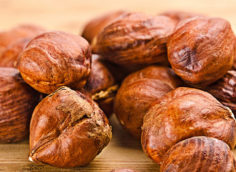Insulin is very anabolic. It's a hormone responsible for carb and amino acid delivery to the muscles for recovery and growth. So you need insulin, but you need to control it.
Insulin sensitivity seems to be the most important factor dictating how the body will handle carbs. Chronic elevation of insulin can increase the rate of transport of fats and carbs into fat cells. Although initially insulin shuttles nutrients into muscle cells, chronic insulin elevation will cause the muscles to become insulin resistant and refuse to take up nutrients. The adipose tissues, however, are greedy little pieces of cellular machinery and continue to take up nutrients at a rapid rate.
For those who have good insulin sensitivity, the body responds to carb intake with small insulin surges. Although the insulin surges are tiny, the cells are very responsive to that small amount of insulin and do a great job of becoming anabolic. Since lots of insulin can inhibit fat loss, the ideal scenario is to become very insulin sensitive so that only small amounts of insulin are required for anabolism, and so that those small amounts of insulin don't prevent fat loss.
Some experts use very simplistic recommendations for testing insulin sensitivity, methods I disagree with. For example, I've heard the statement that if you have an apple-shaped physique or if you get sleepy after a carb meal then you're insulin resistant (insensitive). These are way too non-specific and tell you very little about your nutrient needs or if you're making progress. I prefer methods that, although more time consuming, are objective.

The first is a oral glucose tolerance test. For this you need to go to your local pharmacy and purchase a glucometer, some glucose test strips, and a standard glucose beverage (ask your pharmacist about this because it has to be a specific kind. Pepsi won't work). Once you've got the goods, you'll plan your test.
After going at least 24 hours without exercise (do this test after a day off from training), you'll wake up in the morning – fasted at least 12 hours – and take a blood sample from your finger tip. Write down this number. Then drink your glucose beverage and continue to take blood samples at 15, 30, 60, 90, and 120 minutes. Record all the numbers at each time point. Here's a little chart of what you should expect:
Insulin Sensitivity and Glucose Tolerance
| Normal | Excellent | |
|---|---|---|
| Fasted Blood Glucose | <100mg/dl | <70mg/dl |
| Peak Blood Glucose | <180mg/dl | <130mg/dl |
| Time to Maximum Blood Glucose Level | 30-60 min. | 15-30 min. |
| Time Back to Fasted Glucose Level | 30-60 min. | 60-90 min. |
The second test is a fasted glucose and insulin test. For this you need to see your doctor. This test is simply a blood draw in the fasted state. It's easy to do. Just schedule an appointment, the nurse will do a single blood draw, and then the lab will measure the levels of insulin and glucose in your blood at this time.
Using one of the following equations, you'll have both an insulin sensitivity score and a pancreatic responsiveness score:
Insulin Sensitivity =
- Fasted Insulin (mU/L) / 22.5 x E to the X e-ln(Fasted Glucose (mmol/L))
or - Fasted Insulin (pmol/L) x (Fasted Glucose (mmol/L) / 135)
Pancreatic Beta Cell Function =
- (20 x Fasted Insulin (mU/L)) / (Fasted Glucose (mmol/L)-3.5)
or - (3.33 x Fasted Insulin (pmol/L) / (Fasted Glucose (mmol/L)-3.5)
If you're not a math whiz or don't own a calculator, have your doctor do the math for you. Remember, you have to go to his office to get the test done in the first place. Once you have these values, compare your numbers to the following to see how sensitive you are:
Insulin Sensitivity
- Lower score = more sensitive
- Normal insulin sensitivity: score should be below 2
- Excellent insulin sensitivity: score will be around 0.5
Pancreatic Beta Cell Function
- Higher = better pancreatic function and insulin release
- Normal pancreatic function: score should be about 100
- Excellent pancreatic function: score will be above 200
Once you've collected these measures, you'll have a better indication of what type of diet you need to consume. Do these tests at least once every few months to see how your diet and training is impacting your insulin sensitivity.
So let's assume that you've done the tests and you weren't happy with the results. You're insulin insensitive and, dammit, you don't like it! Well, instead of resigning yourself to a flabby midsection for the remainder of your days there are some things you can do to increase insulin sensitivity.
Both aerobic and resistance training greatly increase insulin sensitivity through a variety of mechanisms. So include both in your program. I've seen tremendous increases in insulin sensitivity with three to four intense weight training sessions per week lasting 1 to 1.5 hours per session. These sessions should be coupled with at least three or four aerobic sessions lasting 30 minutes per session. To really target insulin sensitivity, you'd want to perform weight training and cardio separately.
In addition, supplements like omega 3 fatty acids, fish oils such as Flameout®, alpha-lipoic acid, and chromium can increase insulin sensitivity. Start out with 600 mg of alpha-lipoic acid (ALA) and concentrated fish oils containing a total of six to ten grams of DHA and EPA (the most active omega 3 fats in fish oils).
On the flip side, stimulants like ephedrine and caffeine can decrease insulin sensitivity due to their effects on metabolism. Furthermore, the low carb, high-fat diets that have become popular can also lead to decreased insulin sensitivity. That's why the people I train don't go on no-carb diets.




